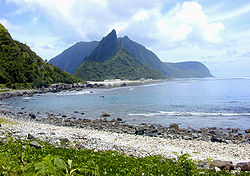The Manu'a Islands (or the Manuʻa tele) are a group of 3 islands 110 kilometers (68 miles) east of the main island, Tutuila. They were home to 1,100 people in 2010.
Understand
[edit]
The group consists of three main islands: Taʻū, Ofu and Olosega. Ofu and Olosega are separated only by the shallow, 137-meter-wide Āsaga Strait, and are now connected by a bridge over the strait. Their combined area is 56 km² (22 sq mi). Taʻu is the largest of these islands, with an area of 44 km² (17 sq mi), and it has the highest point of the Manuʻa, at 931 m (3,054 ft).
All three islands are high islands: volcanic remnants rising out of the sea 14° south of the equator. The islands are elevated and mountainous.

Villages:
- Faleasao
- Leusoali'i
- Maia
- Ofu-Olosega — twin islands that are a natural paradise, with gorgeous green cliffs, beaches and bright blue lagoons. There is a weekly flight from Pago Pago.
- Luma
- Lalomoana
The people of Manuʻa speak the Samoan language.
Manu'a District has the lowest average per capita income in the United States.
History
[edit]According to historical Samoan oral tradition, Manu'a was once the ruling center of a large Polynesian empire that included the entire Samoan archipelago, and other nearby islands, including Tonga and Fiji. The traditional capital of Manuʻa is the village of Taʻū, on the island of Taʻū.
Get in
[edit]The islands are accessible on a Samoa Airways[dead link] flight from Pago Pago to Fitiuta Airport (FTI IATA) on Taʻū (3 flights/week as of July 2022), or by boat from Tutuila.
